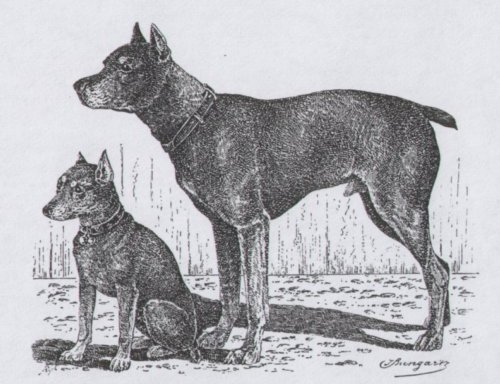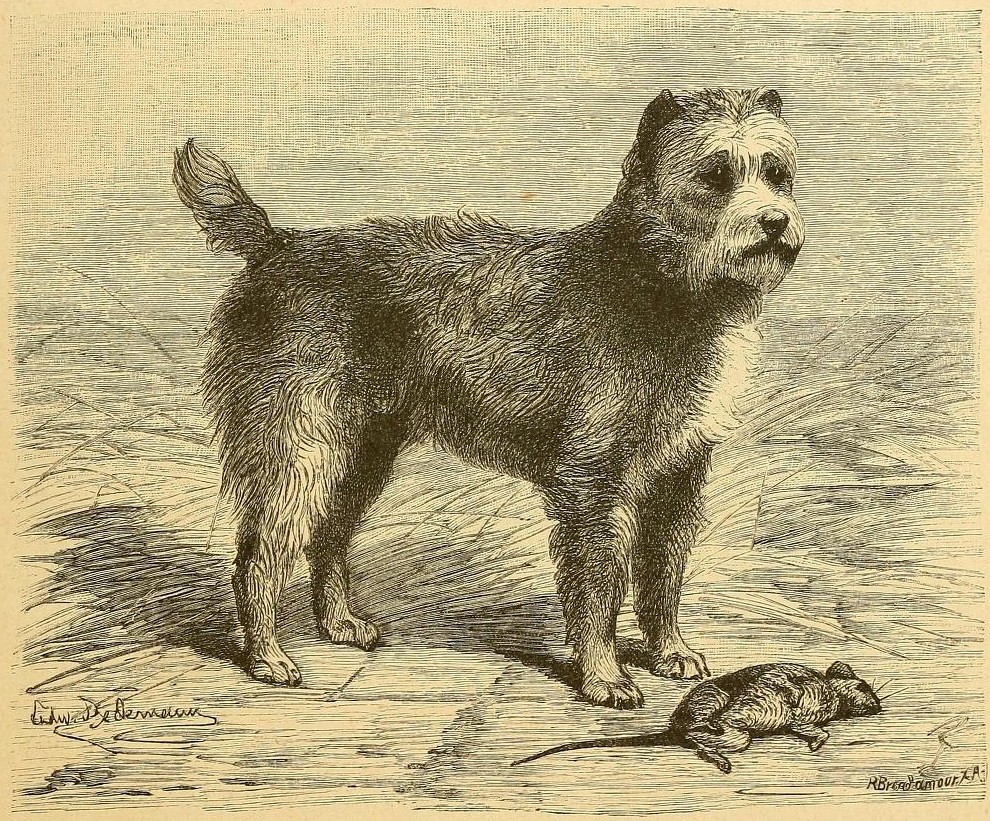|
Pinscher
The Pinscher is a group of German dog breeds, developed originally as ratters on farms or as guard dogs. In the twenty-first century they are commonly kept as companion animals. Origins It is considered that the German Pinscher is a prototypical Pinscher and one of the oldest German breeds, more closely related to the Standard Schnauzer (once known as the Wire-Haired Pinscher) than the Dobermann and other Pinschers. Since the mid-19th century, breeders stopped crossbreeding these coat types, and with the formation of the German Pinscher-Schnauzer-Club (PSK) in 1895, advanced them to distinct breed varieties. Etymology There are several theories on the etymology of the word Pinscher; that it derives from French "pincer", meaning "to seize" and "to nip", or "to bite" and "to grip" which are possibly related to their function of catching vermin on the farm, that it derives from English "pinch" referring to their clipped ears, "fox terrier" type of dog (considered that it wa ... [...More Info...] [...Related Items...] OR: [Wikipedia] [Google] [Baidu] |
Miniature Pinscher
The Miniature Pinscher, also known as the Zwergpinscher, Mini Pin and Min Pin for short, is a small breed of dog of the pinscher type originating in Germany. While the breed's visual similarities to the Toy Manchester Terrier, which somewhat resembles the Pinscher breeds, remain a matter of controversy, genetic research (published in 2017) has shown that the two breeds have shared, unique ancestry. The ancestors of the Toy Manchester and Miniature Pinscher may have become geographically separated many centuries ago and retained similarities simply through breeding selection for the same traits; nevertheless, the 2017 research also showed that the two breeds remain more closely related to each other than to other breeds. The breed's ancestors may also include the German Pinscher, Italian greyhounds and dachshunds. The Miniature Pinscher's known origins are in Germany, where it was often referred to as the Zwerg Pinscher (Dwarf Biter) in historical documents. German Kennel Club docume ... [...More Info...] [...Related Items...] OR: [Wikipedia] [Google] [Baidu] |
Dobermann
The Dobermann is a German list of dog breeds, breed of medium-large working dog of pinscher type. It was originally bred in Thuringia in about 1890 by Karl Friedrich Louis Dobermann, Louis Dobermann, a tax collector."Get to Know the Doberman Pinscher" , 'The American Kennel Club', retrieved 6 May 2014 It has a long muzzle and – ideally – an even and graceful gait. The ears were traditionally Cropping (animal), cropped and the tail docking (dog), docked, practices which are now illegal in many countries. The Dobermann is intelligent, alert and tenaciously loyal; it is kept as a guard dog or as a companion animal. In Canada and the United States it is known as the Doberman Pinscher. History [...More Info...] [...Related Items...] OR: [Wikipedia] [Google] [Baidu] |
German Pinscher
The German Pinscher or is a German breed of terrier in the Pinscher and Schnauzer group. It shares common origins with the Schnauzer, of which it is essentially a short-haired equivalent. It is seen in two colours, either black-and-tan or self-coloured red, this varying from deer-red to a dark reddish brown. It is an endangered breed, and is listed in category III of the Rote Liste of the Gesellschaft zur Erhaltung alter und gefährdeter Haustierrassen. It is a distinct and separate breed from the Affenpinscher, the Austrian Pinscher and the Miniature Pinscher or Zwergpinscher. History The origins of the German Pinscher are unknown. Dogs of this type, both rough-haired and smooth-haired, were traditionally kept as carriage dogs or as stable dogs, and so were sometimes known as ; they were capable ratters. Both types were known as Deutscher Pinscher, and came from the same lineage; rough-haired and smooth-haired puppies could occur in the same litter. The rough-haired ... [...More Info...] [...Related Items...] OR: [Wikipedia] [Google] [Baidu] |
Austrian Pinscher
The Austrian Pinscher (Österreichischer Pinscher) is a medium-sized breed of pinscher-type dog from Austria, where dogs of the type were originally farm dogs, keeping barns free of rats and acting as home guards, livestock guardians, and drovers. The name originally given to the breed in 1928 was the ''Österreichischer Kurzhaarpinscher'' (''Austrian Shorthaired Pinscher'') to differentiate it from similarly named breeds, but today in its country of origin the breed is officially called the Österreichischer Pinscher, or Austrian Pinscher in English. Appearance Like other farm dogs raised for work rather than for pets or show, the appearance can vary a great deal, although there is a definite breed standard.The Look Austrian Pinscher Club (in German) In general, the Austrian Pinscher is a normally proportioned strong and sturdy dog, at t ... [...More Info...] [...Related Items...] OR: [Wikipedia] [Google] [Baidu] |
Standard Schnauzer
The Schnauzer or Mittelschnauzer is a German dog breed, breed of dog in the Pinscher and Schnauzer group. It is characterised by an abundant bristly beard and whiskers, usually lighter than the coat. It is one of three Schnauzer breeds, the others being the Giant Schnauzer or Riesenschnauzer, and the Miniature Schnauzer or Zwergschnauzer. In Germany it is an endangered breed, and is listed in category III of the Rote Liste of the Gesellschaft zur Erhaltung alter und gefährdeter Haustierrassen. Its development as a breed dates from the 1880s, in southern Germany. It is a robust and squarely-built dog of medium size, of Working group (dogs), working or Utility group, utility type; the coat may be salt-and-pepper or black. A dog of this type was exhibited in Hanover in 1879; another was "Westminster Kennel Club Dog Show, Best in Show" at the Westminster Kennel Club in the United States in 1997. History Neither the origin of the breed name, nor when it came into use, is known. T ... [...More Info...] [...Related Items...] OR: [Wikipedia] [Google] [Baidu] |
Affenpinscher
The Affenpinscher () is a German list of dog breeds, breed of small toy dog of Pinscher type. Originally developed as a Ratter (dog), mouser, the Affenpinscher is now commonly found as a Companion dog, companion worldwide. History The word '' derives from , German for 'ape' or 'monkey'; it is sometimes translated as 'Monkey Terrier', although the dog is a pinscher and not a terrier. The origins of the Pinscher group of dogs are unknown. Dogs of this type, both rough-haired and smooth-haired, were traditionally kept as carriage dogs or as stable dogs, and so were sometimes known as ; they were capable ratter (dog), ratters. Until the late nineteenth century, both rough-haired and smooth-haired types were known as Deutscher Pinscher, and came from the same lineage; puppies of both types could occur in the same litter. In 1880 the Pinscher was recorded in the ''Deutschen Hundestammbuch'' of the Verein zur Veredelung der Hunderassen. In 1895 described five varieties of Pinscher ... [...More Info...] [...Related Items...] OR: [Wikipedia] [Google] [Baidu] |
Ratter (dog)
A ratter is any dog used for catching and killing Rat, rats and similar vermin. Specialized rat-catching Dog breed, breeds are found in many countries. A typical ratter is small to medium-sized and has a short and smooth coat, however a wide range of dog breeds and landraces may be used. The use of ratting dogs is widely considered to be the most environmentally friendly, humane and efficient methods of exterminating rodents. Ratting dogs are considered more efficient than Cat, domestic cats. History Ratting has existed for centuries, especially in Europe. The Centers for Disease Control and Prevention list over 20 diseases directly linked to rats, making ratting dogs popular as a way of curbing disease Rats are associated with damage to crops and buildings. In Middle Ages, Medieval times, Rat-catcher, rat-catchers were employed to curb the spread of disease. Rat-catchers who employed dogs were considerably more successful and rat-catchers with packs of ratting dogs would f ... [...More Info...] [...Related Items...] OR: [Wikipedia] [Google] [Baidu] |
List Of Dog Breeds
This list of dog breeds includes both Neontology#Extant taxa versus extinct taxa, extant and extinct dog breeds, Designer breed, varieties and dog type, types. A research article on dog genomics published in Science/AAAS defines modern dog breeds as "a recent invention defined by conformation to a physical ideal and purity of lineage". According to BigThink, over 40% of the world's dog breeds come from the United Kingdom, France and Germany. It states: "Great Britain and France are the ground zero of dog fancying, with 57 registered breeds each. Germany is not far behind, with 47 breeds. These three countries alone represent more than 40% of all dog breeds recognized by the Fédération Cynologique Internationale." Extant breeds, varieties and types A–C D–K L–R S–Z Extinct and critically endangered breeds, varieties and types See also * Dog type * List of dog crossbreeds * List of Italian dog breeds * List of dog breeds from India * List of Tibetan d ... [...More Info...] [...Related Items...] OR: [Wikipedia] [Google] [Baidu] |
Cropping (animal)
Cropping is the removal of part or all of the external flaps of an animal's ear. The procedure sometimes involves bracing and taping the remainder of the ears to train them to point upright. Almost exclusively performed on dogs, it is an old practice that was once done for perceived health, practical or cosmetic reasons. Veterinary science states there is no medical or physical advantage to the animal from the procedure,Slatter, Douglas H. (2002''Textbook of small animal surgery''3rd edition. Philadelphia: W.B. Saunders (imprint of Elsevier Health Sciences), 2896 pages, , p.1746 leading to concerns of animal cruelty over performing unnecessary surgery on animals. In modern times, cropping is banned in many nations, but is still legal in a limited number of countries. Where permitted, it is seen only in certain breeds of dog, such as pit bull and bull terrier type breeds, the Doberman Pinscher, Schnauzer, Great Dane, Boxer and Cane Corso. History and purposes Historically, ... [...More Info...] [...Related Items...] OR: [Wikipedia] [Google] [Baidu] |
Fédération Cynologique Internationale
The (; FCI; ) is the largest international federation of national kennel clubs and purebred registries. The FCI is based in Thuin, Belgium and has 98 members and contract partners (one from each country). History The FCI was founded in 1911 under the auspices of the kennel clubs of Austria, Belgium, France, Germany and the Netherlands. Its objective was to bring global uniformity to the breeding, exhibiting and judging of pure-bred dogs. It was disbanded in World War I and recreated in 1921 by Belgium and France. Since its foundation the FCI's membership has grown to include kennel clubs from the majority of countries worldwide, with members in Europe as well as Africa, the Americas, Asia and Oceania. Function The purpose of the FCI is to make sure that the pedigrees and judges are mutually recognised by all the FCI member countries. In contrast to national kennel clubs, the FCI is not a registry and does not issue pedigrees to individual dogs, with the issue of pedigrees and ... [...More Info...] [...Related Items...] OR: [Wikipedia] [Google] [Baidu] |
Harlequin Pinscher
Harlequin (, , ; , ) is the best-known of the comic servant characters (Zanni) from the Italian commedia dell'arte, associated with the city of Bergamo. The role is traditionally believed to have been introduced by the Italian actor-manager Zan Ganassa in the late 16th century, was definitively popularized by the Italian actor Tristano Martinelli in Paris in 1584–1585, and became a stock character after Martinelli's death in 1630. The Harlequin is characterised by his checkered costume. His role is that of a light-hearted, nimble, and astute servant, often acting to thwart the plans of his master, and pursuing his own love interest, Columbine, with wit and resourcefulness, often competing with the sterner and melancholic Pierrot. He later develops into a prototype of the romantic hero. Harlequin inherits his physical agility and his trickster qualities, as well as his name, from a mischievous "devil" character in medieval Passion Plays. The Harlequin character first appeare ... [...More Info...] [...Related Items...] OR: [Wikipedia] [Google] [Baidu] |




